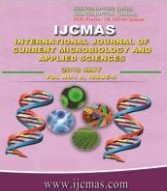


 National Academy of Agricultural Sciences (NAAS)
National Academy of Agricultural Sciences (NAAS)

|
PRINT ISSN : 2319-7692
Online ISSN : 2319-7706 Issues : 12 per year Publisher : Excellent Publishers Email : editorijcmas@gmail.com / submit@ijcmas.com Editor-in-chief: Dr.M.Prakash Index Copernicus ICV 2018: 95.39 NAAS RATING 2020: 5.38 |
The present study was conducted on 12 dogs of either, sex, breed, aged between 1-8 years brought to T.V.C.C, Jabalpur having a diaphyseal fracture in any of the long bones i.e. Humerus, femur and tibia. The dogs were randomly divided into three equal groups irrespective of breed and sex. The radiographs in two standard views were taken to diagnose the fracture and to select optimum titanium pins. In all the three groups, the diaphyseal fractures were repaired with internal fixation using titanium elastic pin. In group I, the fracture was repaired by using the titanium pin alone. In group II, along with internal fixation bone loss or bone gap in fractures site were filled by decellularised xenogeneic cancellous bone chip graft, while in group III, bone loss or gap at fracture site was filled and packed with granules of beta tricalcium phosphate (β- TCP). A 5 ml blood was collected from each animal on the day of surgery and at different time intervals up to 60th post-operative day for haemato-biochemical estimation. Haemato-biochemical parameters like haemoglobin, total erythrocyte count, total leucocyte counts and differential leukocyte count included neutrophil, lymphocyte, eosinophil, basophil and monocyte activity and serum calcium, phosphorus and alkaline phosphatase enzyme activity during fracture healing were analyzed and found that the above all haemato-biochemical parameters on different post-operative days provided much help in assessing source of fracture healing.
 |
 |
 |
 |
 |